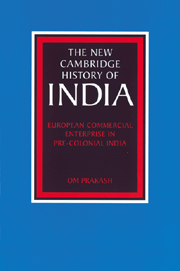Book contents
- Frontmatter
- Dedication
- Contents
- List of figures
- List of maps
- List of tables
- General editor's preface
- Preface
- Introduction
- 1 India in the Indian Ocean trade, circa 1500
- 2 The Portuguese in India, 1500–1640
- 3 The European trading companies: exports from Europe and the generation of purchasing power in Asia
- 4 The companies in India: the politics and the economics of trade
- 5 Euro-Asian and intra-Asian trade: the phase of Dutch domination, 1600–1680
- 6 The VOC and the growing competition by the English and the French, 1680–1740
- 7 The supremacy of the English East India Company, 1740–1800
- 8 European trade and the Indian economy
- 9 Conclusion
- Bibliographic Essay
- Index
- Misc-endmatter
- Map 1 Important trading centres in Asia in the seventeenth and eighteenth centuries"
- Map 2 Portuguese seaborne empire, c. 1580"
- Map 3 The Indian Ocean in the seventeenth and eighteenth centuries, showing the settlements of the English East India Company and of other European nations"
- Map 4 India: main textile–weaving areas, 1600–1750"
- References
7 - The supremacy of the English East India Company, 1740–1800
Published online by Cambridge University Press: 28 March 2008
- Frontmatter
- Dedication
- Contents
- List of figures
- List of maps
- List of tables
- General editor's preface
- Preface
- Introduction
- 1 India in the Indian Ocean trade, circa 1500
- 2 The Portuguese in India, 1500–1640
- 3 The European trading companies: exports from Europe and the generation of purchasing power in Asia
- 4 The companies in India: the politics and the economics of trade
- 5 Euro-Asian and intra-Asian trade: the phase of Dutch domination, 1600–1680
- 6 The VOC and the growing competition by the English and the French, 1680–1740
- 7 The supremacy of the English East India Company, 1740–1800
- 8 European trade and the Indian economy
- 9 Conclusion
- Bibliographic Essay
- Index
- Misc-endmatter
- Map 1 Important trading centres in Asia in the seventeenth and eighteenth centuries"
- Map 2 Portuguese seaborne empire, c. 1580"
- Map 3 The Indian Ocean in the seventeenth and eighteenth centuries, showing the settlements of the English East India Company and of other European nations"
- Map 4 India: main textile–weaving areas, 1600–1750"
- References
Summary
From the standpoint of the European companies' trade in India, the second half of the eighteenth century constituted a distinct category characterized by developments of far-reaching import. We noted earlier that around 1740, in terms of its overall trading operations in Asia, the Dutch East India company was still distinctly ahead of its English rival, though in terms of Euro-Asian trade alone, the latter had already taken a lead. This situation had been altered radically by the time we reach 1780 or so. The greater part of the change took place in the years after 1760. Thus the value of the total English imports from Asia into Europe, which had stood at the equivalent of f.23 million over the triennium 1738–40 and had gone up marginally to f.25 million during 1758–60, reached the incredible figure of f.69 million over the triennium 1777–9 (Table 4.2). Bengal continued to account for over half the total imports, while the share of China came down from a third during 1758–60 to under a quarter during 1777–9 (Table 4.3). As against this, the value of the total Dutch imports into Europe had gone up only marginally from f.19 million during 1738–40 to f.21 million during 1778–80. The only major change in the composition of the Dutch imports had been a decline in the share of tea from 32 to 27 per cent, and a rise in that of textiles and raw silk from 41 to 49 per cent (Table 4.1). In absolute terms, the value of textiles and raw silk in the total imports had gone up from f.7.91 million during 1738–40 to f.10.28 million during 1778–80.
Keywords
- Type
- Chapter
- Information
- European Commercial Enterprise in Pre-Colonial India , pp. 268 - 314Publisher: Cambridge University PressPrint publication year: 1998

